
Character key
Paula Rego’s ‘Crivelli’s Garden’ tells the story of women from biblical history and folklore based on paintings in the collection and stories from the Golden Legend.
Figures including the Virgin Mary, Saint Catherine, Mary Magdalene and Delilah are in Rego's re-imagined garden surrounded by Portuguese blue and white tiled walls.
The images of these courageous and strong women were based on the people that Rego knew, including friends, family and members of the National Gallery staff at the time.

Use the key
Shaded in blue in the images below are the National Gallery staff, mythological subjects and saints in Rego's garden. Find a short description of each one below.
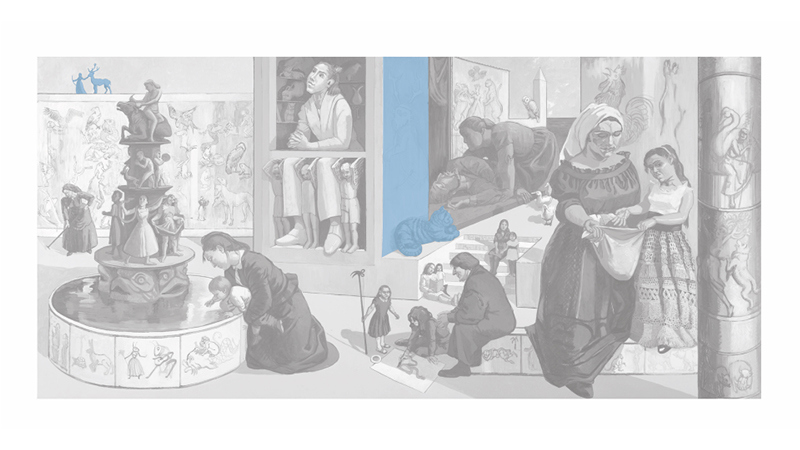
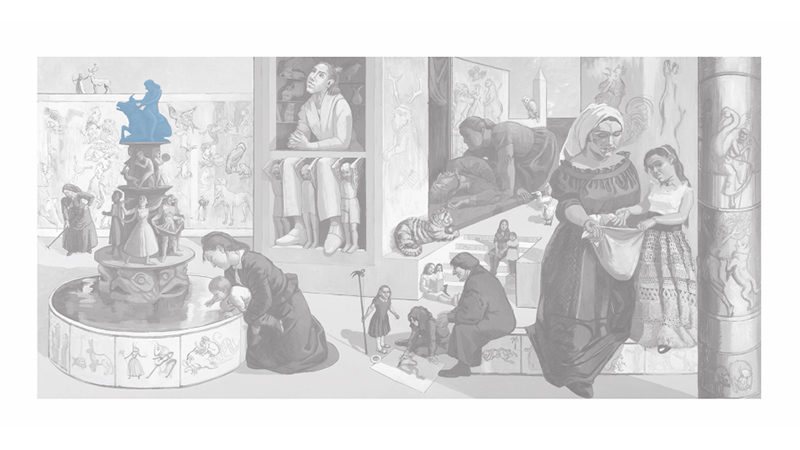
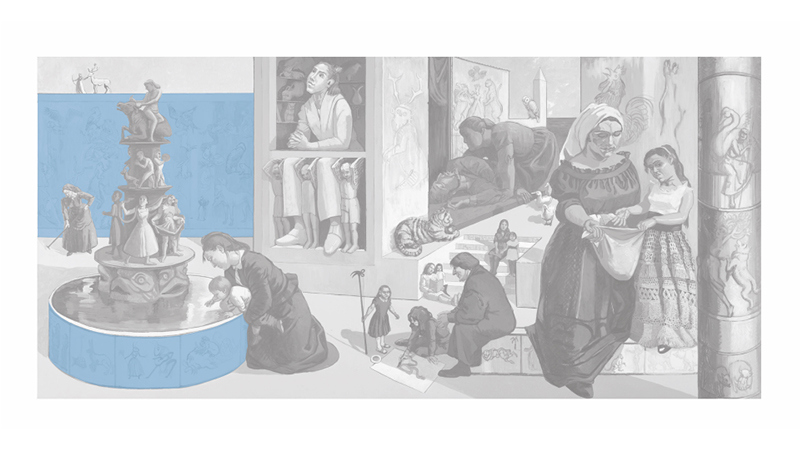
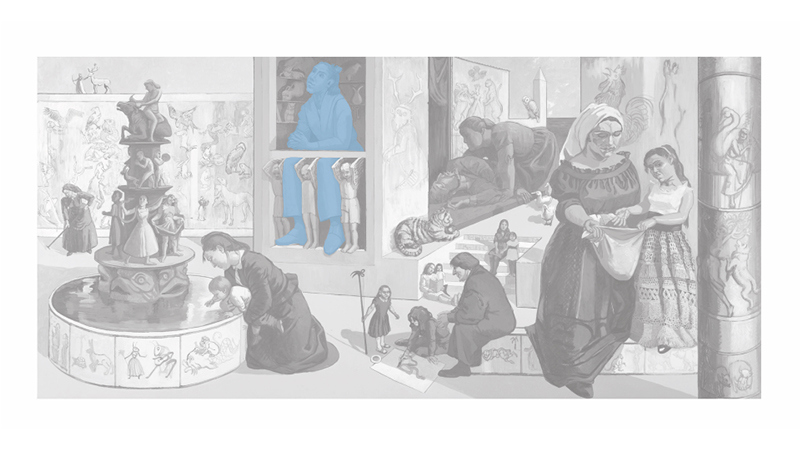
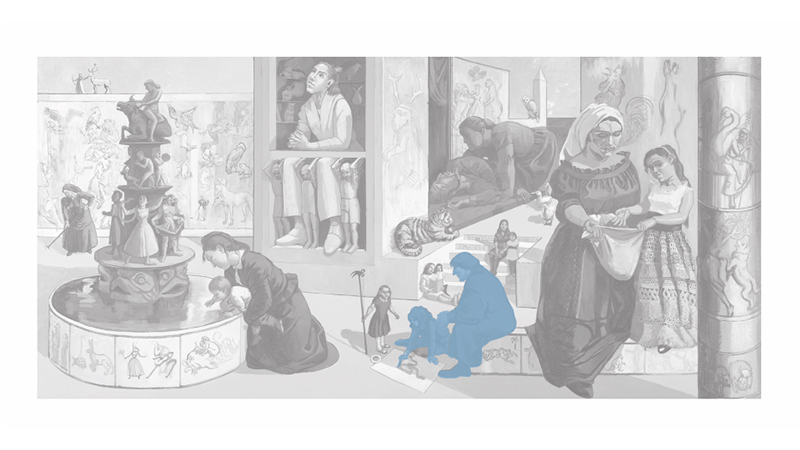
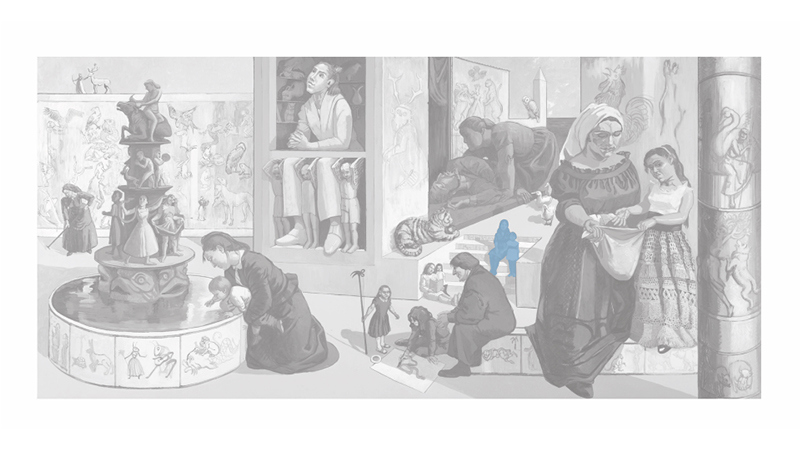
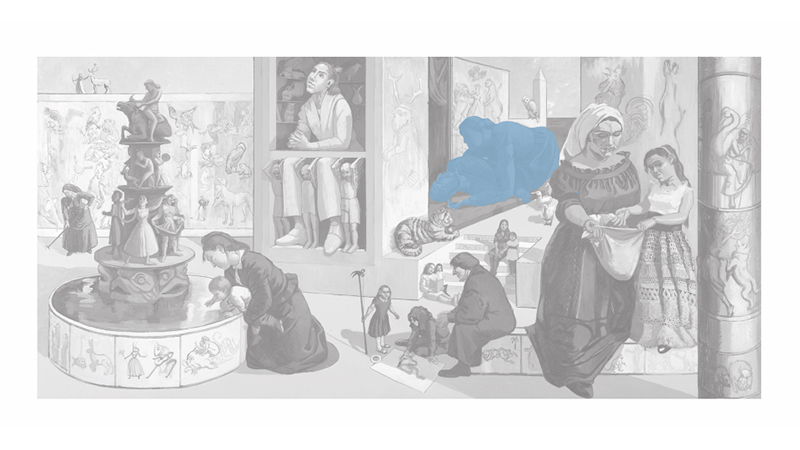
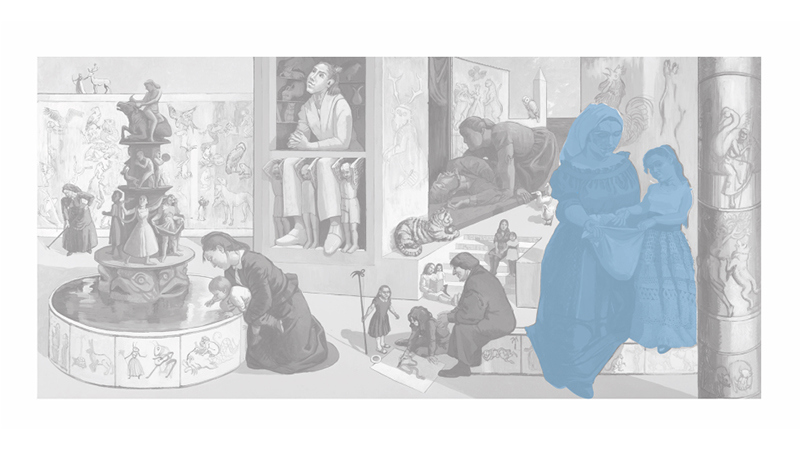
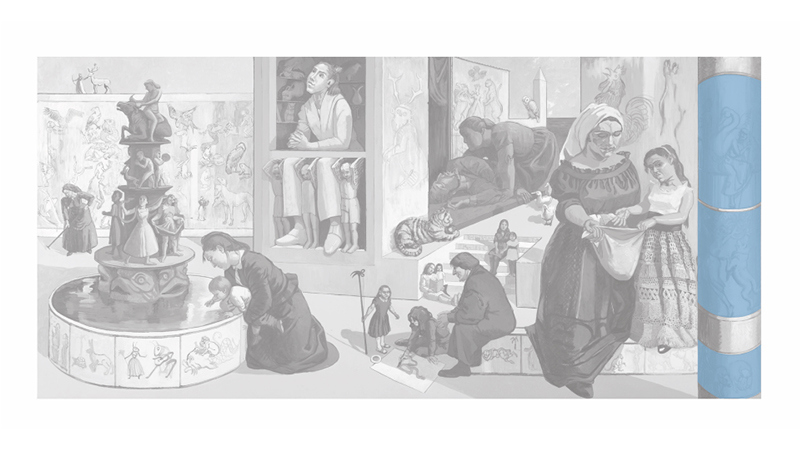

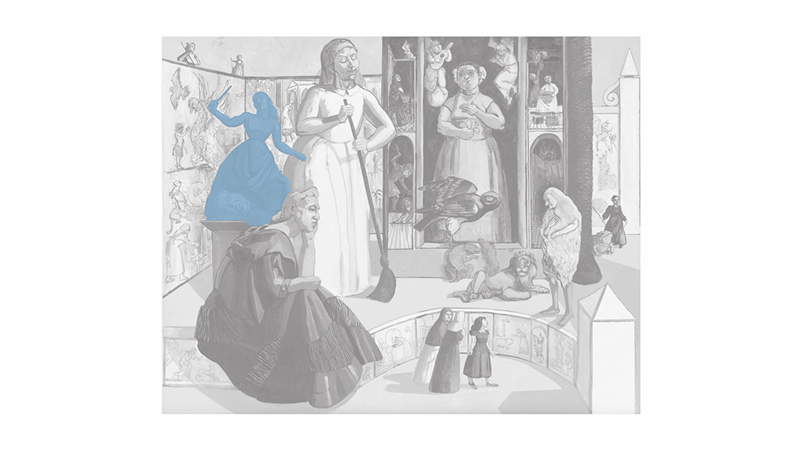
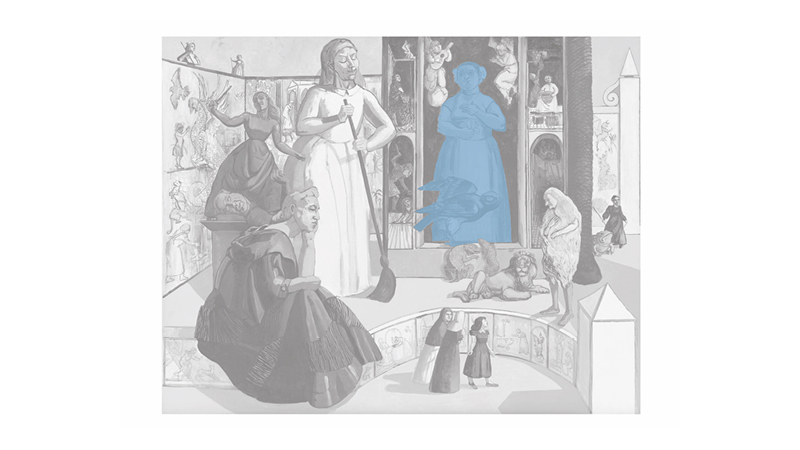
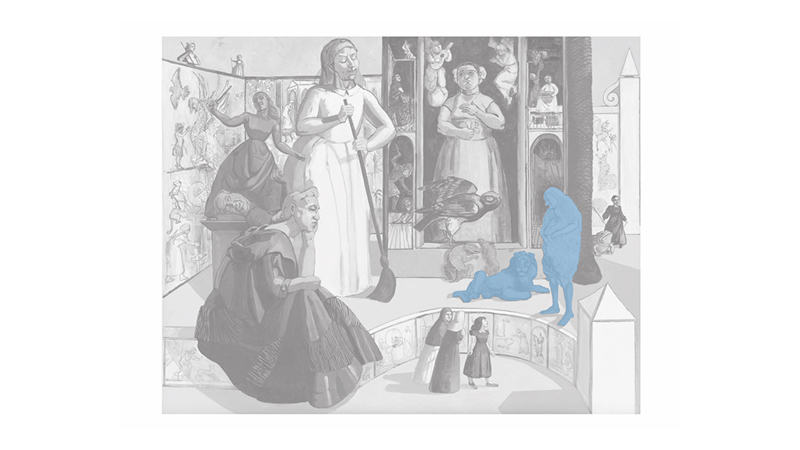
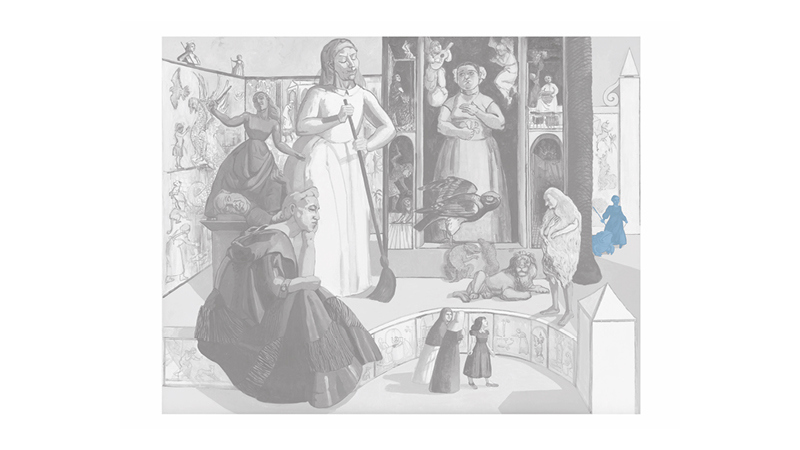
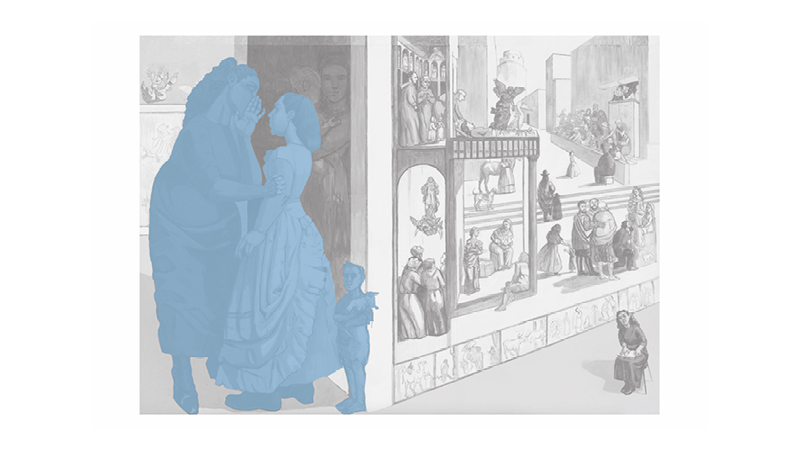
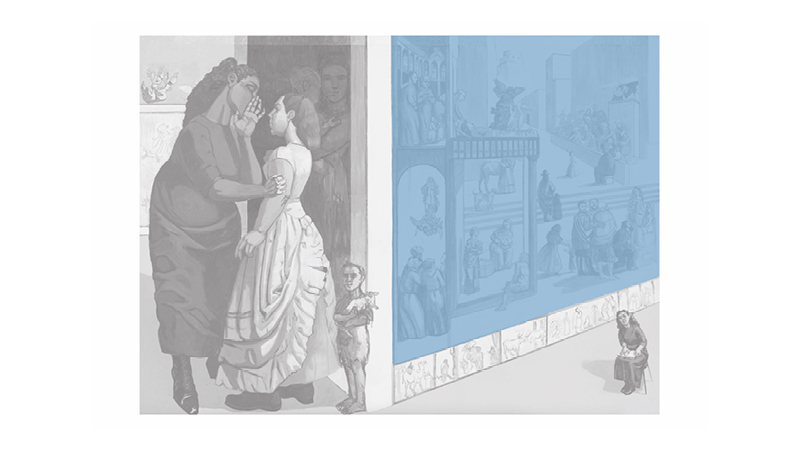
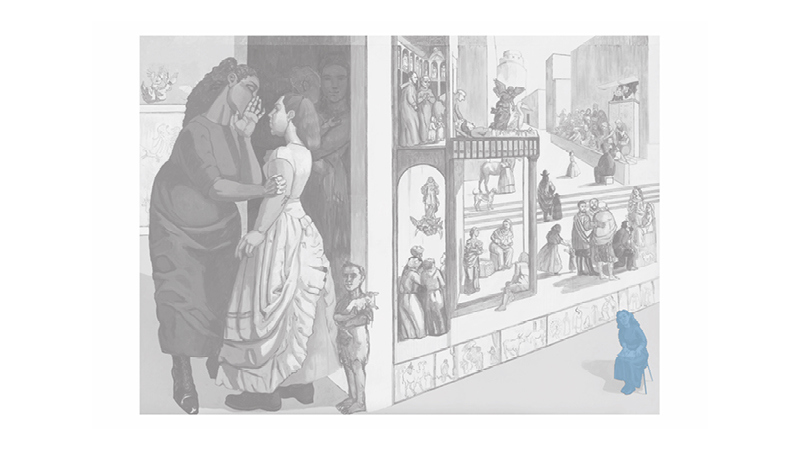
Diana and Actaeon
The story of Diana and Actaeon from Ovid’s Metamorphoses appears twice in this panel. Diana, the goddess of the hunt, transforms the mortal Actaeon into a stag after he stumbles across her while bathing. In Titian’s painting of the story, we see Actaeon as a stag subsequently being pursued and
killed by his own hounds.
The Rape of Europa
In Ovid’s Metamorphoses, Zeus takes the form of a bull to entice the princess Europa in order to abduct her. Here, Rego paints Europa taking charge and literally ‘taking the bull by the horns.’
Walls and plinths
Aesop’s Fables and tales from Ovid are illuminated across the walls and plinths of 'Crivelli’s Garden'.
They are painted in blue and white to reflect the popular and iconic form of showing stories in the
two-toned glazed tiles on interior and exterior walls of Portuguese buildings.
Mary Magdalene
National Gallery lecturer, Lizzie Perrotte, sat for this painting of the biblical figure Mary Magdalene, shown here in a niche surrounded by mystical wares.
The Storyteller
The figure of the Storyteller is based on the likeness of Erika Langmuir, Head of Learning at the National Gallery when Rego was Associate Artist. She peers over a young girl drawing a snake, who is based on Langmuir’s junior colleague, Ailsa Bhattacharya.
Figures on the stairs
This woman and young girl are inspired by an old photograph of Rego with her daughter Cassie as a child.
Samson and Delilah
In the Old Testament, Delilah betrays Samson to the Philistines by revealing to them that the secret
to his Herculean strength lay in his hair.
Rather than show Delilah passive under the heavy body of her lover in slumber, as in Rubens’s painting, Rego shows her crawling over the sleeping and vulnerable Samson, as if stalking her prey.
Judith and her maid
These figures are based on the biblical story of the widow Judith beheading Holofernes, an Assyrian general, who was soon to destroy her home city. Judith, shown as a young girl, places a large object into the apron of her maid, alluding to Holofernes's severed head.
Greek mythologies in the column
Three popular Greek mythological stories are reimagined in this central column: Leda and the Swan (in which Zeus seduces Leda), Daphne and Apollo (in which Daphne becomes a laurel tree in order to escape Apollo’s advances), and the sorceress Circe (turning Odysseus’s men into pigs).
Saint Martha and Mary Magdalene
Saint Martha is shown diligently sweeping the floor in a long white dress, while Mary Magdalene sits in contemplation at her feet, herself dressed in a black dress with a voluminous skirt.
Saint Catherine
Rego’s rendition of Catherine of Alexandria, wields a sword overhead after decapitating the Roman Emperor Maxentius as vengeance for his ordering of her torture. She stands over his severed head, which was modelled on Rego’s friend and lover Rudi Nassauer.
Saint Cecilia
Saint Cecilia is set in a niche surrounded by episodes from her torments and accompanied by a hawk to symbolise her nobility. According to the Golden Legend, she lived for three days after having been struck three times in her neck by a sword.
Mary of Egypt
Saint Mary of Egypt is shown shrouded in her own hair which grew so long that it covered her nakedness. She became a hermit in the desert after renouncing her life as a prostitute. Here she is accompanied by a lion: the animal that eventually buried her.
Saint Margaret
According to the Golden Legend, Saint Margaret was swallowed by the devil in the form of a dragon that she had befriended, before erupting from his stomach.
She became known thereafter as the patron saint of women in labour. In her hand, she holds a lead that is tied to a large frog which represents the dragon demoted to a subordinate state and is symbolic of the saint overcoming her own misfortunes.
The Visitation
In Rego’s version of the Visitation, the Virgin Mary and her cousin Elizabeth, both pregnant with Christ and John the Baptist respectively, exclude the viewer from their conversation. Elizabeth grasps Mary’s upper arm with one hand and shields her own mouth with the other, hiding their discussion. Disrupting any sense of linear time, saint John also features in front of them as a young boy holding a lamb, and a faint image of Mary holding the baby Christ appears on the wall behind them.
Mural of the episodes from the life of the Virgin Mary
Various scenes from the life of the Virgin are shown on the large wall within the painting, including the Annunciation, the Flight into Egypt, the Dormition and the Assumption of the Virgin among others.
The Reader
Rego once described this figure of the woman with her book in the rightmost corner of 'Crivelli’s Garden' as, ‘the reader; she is certainly the start of it all, really; the anchor figure’. Modelled on Ailsa Bhattacharya, a member of the Gallery’s education team at the time, she became a key figure for the work; perhaps the storyteller narrating the encounters found across the painting.

















Diana and Actaeon
The story of Diana and Actaeon from Ovid’s Metamorphoses appears twice in this panel. Diana, the goddess of the hunt, transforms the mortal Actaeon into a stag after he stumbles across her while bathing. In Titian’s painting of the story, we see Actaeon as a stag subsequently being pursued and
killed by his own hounds.
The Rape of Europa
In Ovid’s Metamorphoses, Zeus takes the form of a bull to entice the princess Europa in order to abduct her. Here, Rego paints Europa taking charge and literally ‘taking the bull by the horns.’
Walls and plinths
Aesop’s Fables and tales from Ovid are illuminated across the walls and plinths of 'Crivelli’s Garden'.
They are painted in blue and white to reflect the popular and iconic form of showing stories in the
two-toned glazed tiles on interior and exterior walls of Portuguese buildings.
Mary Magdalene
National Gallery lecturer, Lizzie Perrotte, sat for this painting of the biblical figure Mary Magdalene, shown here in a niche surrounded by mystical wares.
The Storyteller
The figure of the Storyteller is based on the likeness of Erika Langmuir, Head of Learning at the National Gallery when Rego was Associate Artist. She peers over a young girl drawing a snake, who is based on Langmuir’s junior colleague, Ailsa Bhattacharya.
Figures on the stairs
This woman and young girl are inspired by an old photograph of Rego with her daughter Cassie as a child.
Samson and Delilah
In the Old Testament, Delilah betrays Samson to the Philistines by revealing to them that the secret
to his Herculean strength lay in his hair.
Rather than show Delilah passive under the heavy body of her lover in slumber, as in Rubens’s painting, Rego shows her crawling over the sleeping and vulnerable Samson, as if stalking her prey.
Judith and her maid
These figures are based on the biblical story of the widow Judith beheading Holofernes, an Assyrian general, who was soon to destroy her home city. Judith, shown as a young girl, places a large object into the apron of her maid, alluding to Holofernes's severed head.
Greek mythologies in the column
Three popular Greek mythological stories are reimagined in this central column: Leda and the Swan (in which Zeus seduces Leda), Daphne and Apollo (in which Daphne becomes a laurel tree in order to escape Apollo’s advances), and the sorceress Circe (turning Odysseus’s men into pigs).
Saint Martha and Mary Magdalene
Saint Martha is shown diligently sweeping the floor in a long white dress, while Mary Magdalene sits in contemplation at her feet, herself dressed in a black dress with a voluminous skirt.
Saint Catherine
Rego’s rendition of Catherine of Alexandria, wields a sword overhead after decapitating the Roman Emperor Maxentius as vengeance for his ordering of her torture. She stands over his severed head, which was modelled on Rego’s friend and lover Rudi Nassauer.
Saint Cecilia
Saint Cecilia is set in a niche surrounded by episodes from her torments and accompanied by a hawk to symbolise her nobility. According to the Golden Legend, she lived for three days after having been struck three times in her neck by a sword.
Mary of Egypt
Saint Mary of Egypt is shown shrouded in her own hair which grew so long that it covered her nakedness. She became a hermit in the desert after renouncing her life as a prostitute. Here she is accompanied by a lion: the animal that eventually buried her.
Saint Margaret
According to the Golden Legend, Saint Margaret was swallowed by the devil in the form of a dragon that she had befriended, before erupting from his stomach.
She became known thereafter as the patron saint of women in labour. In her hand, she holds a lead that is tied to a large frog which represents the dragon demoted to a subordinate state and is symbolic of the saint overcoming her own misfortunes.
The Visitation
In Rego’s version of the Visitation, the Virgin Mary and her cousin Elizabeth, both pregnant with Christ and John the Baptist respectively, exclude the viewer from their conversation. Elizabeth grasps Mary’s upper arm with one hand and shields her own mouth with the other, hiding their discussion. Disrupting any sense of linear time, saint John also features in front of them as a young boy holding a lamb, and a faint image of Mary holding the baby Christ appears on the wall behind them.
Mural of the episodes from the life of the Virgin Mary
Various scenes from the life of the Virgin are shown on the large wall within the painting, including the Annunciation, the Flight into Egypt, the Dormition and the Assumption of the Virgin among others.
The Reader
Rego once described this figure of the woman with her book in the rightmost corner of 'Crivelli’s Garden' as, ‘the reader; she is certainly the start of it all, really; the anchor figure’. Modelled on Ailsa Bhattacharya, a member of the Gallery’s education team at the time, she became a key figure for the work; perhaps the storyteller narrating the encounters found across the painting.
Crivelli as inspiration
The mural’s concept and structure were triggered by the predella panel of Carlo Crivelli’s altarpiece La Madonna della Rondine (The Madonna of the Swallow; after 1490) made for S. Francesco dei Zoccolanti, Matelica (a small town in the Marches, Italy).
Each of the five scenes of the panel is dedicated to a saint. Flanked at either end with depictions of Saint Catherine and Saint George, the stories of the Nativity, Saint Jerome and Saint Sebastian are shown in scenes with acute linear perspectives. Rego imagined a world in which Crivelli’s saints would co-exist within the same space and so decided to create her own version of the garden.
Learn more about the predella and its altarpiece and zoom into the details.


